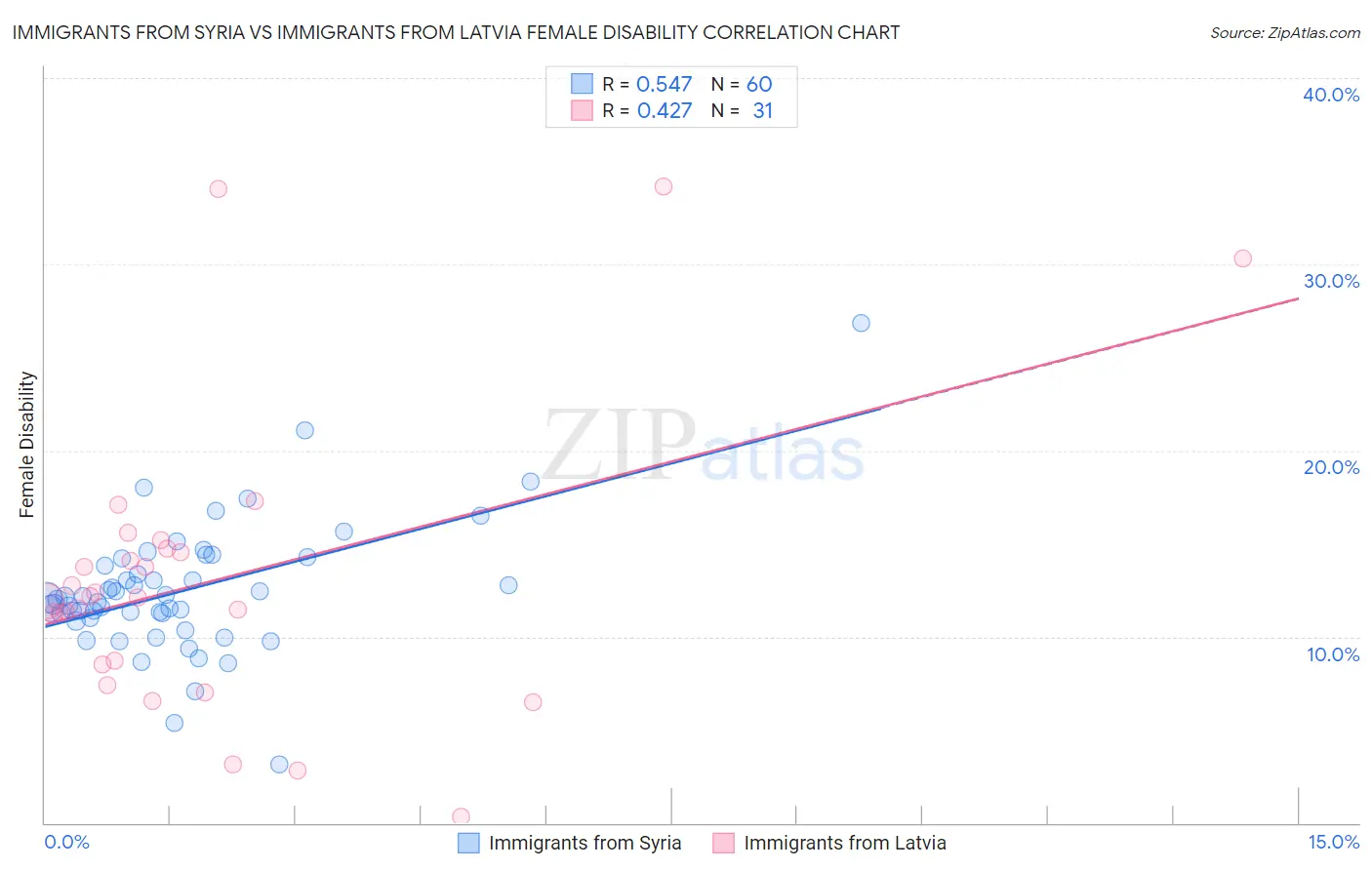Immigrants from Syria vs Immigrants from Latvia Female Disability
COMPARE
Immigrants from Syria
Immigrants from Latvia
Female Disability
Female Disability Comparison
Immigrants from Syria
Immigrants from Latvia
11.9%
FEMALE DISABILITY
94.6/ 100
METRIC RATING
132nd/ 347
METRIC RANK
11.8%
FEMALE DISABILITY
95.6/ 100
METRIC RATING
128th/ 347
METRIC RANK
Immigrants from Syria vs Immigrants from Latvia Female Disability Correlation Chart
The statistical analysis conducted on geographies consisting of 174,112,013 people shows a substantial positive correlation between the proportion of Immigrants from Syria and percentage of females with a disability in the United States with a correlation coefficient (R) of 0.547 and weighted average of 11.9%. Similarly, the statistical analysis conducted on geographies consisting of 113,739,259 people shows a moderate positive correlation between the proportion of Immigrants from Latvia and percentage of females with a disability in the United States with a correlation coefficient (R) of 0.427 and weighted average of 11.8%, a difference of 0.21%.

Female Disability Correlation Summary
| Measurement | Immigrants from Syria | Immigrants from Latvia |
| Minimum | 3.1% | 0.34% |
| Maximum | 26.8% | 34.2% |
| Range | 23.7% | 33.8% |
| Mean | 12.5% | 13.0% |
| Median | 12.0% | 12.1% |
| Interquartile 25% (IQ1) | 11.1% | 8.5% |
| Interquartile 75% (IQ3) | 14.0% | 14.7% |
| Interquartile Range (IQR) | 2.9% | 6.2% |
| Standard Deviation (Sample) | 3.5% | 7.8% |
| Standard Deviation (Population) | 3.5% | 7.6% |
Demographics Similar to Immigrants from Syria and Immigrants from Latvia by Female Disability
In terms of female disability, the demographic groups most similar to Immigrants from Syria are Kenyan (11.9%, a difference of 0.010%), Immigrants from Nicaragua (11.9%, a difference of 0.010%), Central American (11.9%, a difference of 0.080%), Arab (11.9%, a difference of 0.10%), and Ugandan (11.9%, a difference of 0.10%). Similarly, the demographic groups most similar to Immigrants from Latvia are Macedonian (11.8%, a difference of 0.030%), South American Indian (11.8%, a difference of 0.040%), Nicaraguan (11.9%, a difference of 0.090%), Arab (11.9%, a difference of 0.12%), and Immigrants from Europe (11.8%, a difference of 0.14%).
| Demographics | Rating | Rank | Female Disability |
| Immigrants | Kazakhstan | 97.0 /100 | #120 | Exceptional 11.8% |
| Immigrants | Netherlands | 96.9 /100 | #121 | Exceptional 11.8% |
| Immigrants | North Macedonia | 96.8 /100 | #122 | Exceptional 11.8% |
| Immigrants | Croatia | 96.7 /100 | #123 | Exceptional 11.8% |
| Russians | 96.5 /100 | #124 | Exceptional 11.8% |
| Immigrants | Italy | 96.4 /100 | #125 | Exceptional 11.8% |
| Immigrants | Europe | 96.2 /100 | #126 | Exceptional 11.8% |
| South American Indians | 95.8 /100 | #127 | Exceptional 11.8% |
| Immigrants | Latvia | 95.6 /100 | #128 | Exceptional 11.8% |
| Macedonians | 95.5 /100 | #129 | Exceptional 11.8% |
| Nicaraguans | 95.2 /100 | #130 | Exceptional 11.9% |
| Arabs | 95.1 /100 | #131 | Exceptional 11.9% |
| Immigrants | Syria | 94.6 /100 | #132 | Exceptional 11.9% |
| Kenyans | 94.5 /100 | #133 | Exceptional 11.9% |
| Immigrants | Nicaragua | 94.5 /100 | #134 | Exceptional 11.9% |
| Central Americans | 94.2 /100 | #135 | Exceptional 11.9% |
| Ugandans | 94.0 /100 | #136 | Exceptional 11.9% |
| Immigrants | Norway | 93.8 /100 | #137 | Exceptional 11.9% |
| Ecuadorians | 93.4 /100 | #138 | Exceptional 11.9% |
| Immigrants | Hungary | 92.8 /100 | #139 | Exceptional 11.9% |
| Romanians | 91.6 /100 | #140 | Exceptional 11.9% |